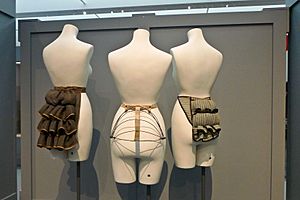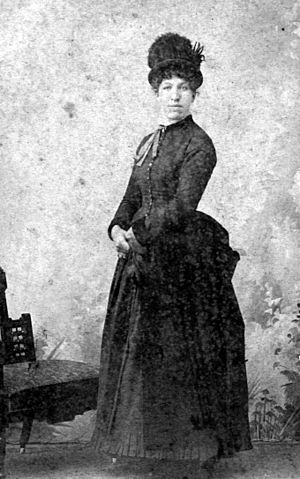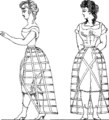Bustle facts for kids
A bustle was a special padded undergarment worn by women in the mid-to-late 1800s. It was used to make the back of their dresses look fuller and to help support the fabric.
Bustles were worn under the skirt, at the back, just below the waist. They helped stop heavy dress fabric from pulling down and flattening the back of a skirt. Without a bustle, a skirt worn over a petticoat or crinoline could lose its shape easily, especially when a woman sat down or moved around.
Contents
History of the Bustle
From Crinoline to Bustle (1867–1872)
Over time, the shape of crinolines (large hoop skirts) changed. Instead of being big and bell-shaped all around, they started to flatten at the front and sides. This made the back of the skirts much fuller. A type of crinoline called a "crinolette" created a shape very similar to what a bustle would later achieve. The extra fabric from the skirt was then gathered and looped towards the back, making it even fuller.
The First Bustles (1869–1876)
The bustle soon became a fashion item on its own. This happened after the outer skirt of the late 1860s was draped up towards the back, and something was needed to support this new draped look. Having some fullness was still important to make the waist look smaller. Eventually, the bustle completely replaced the crinoline. Bustles were worn in different shapes for most of the 1870s and 1880s. There was a short time, from 1878 to 1882, when dresses had flat backs without bustles.
When bustles first became popular, the fullness at the back of the skirts was quite low and often spread out to form a train. You can see how fashion changed from the huge crinoline skirts of the 1850s and 1860s by looking at the loops and gathers of fabric from this time. Later, the bustle became a much more noticeable hump shape right below the waist. The skirt fabric then fell sharply to the floor, completely changing the shape of the dress.
The Big Bustle Era (1881–1889)
The bustle came back in late 1881. It became very popular and even exaggerated in the mid-1880s. By 1885, some bustles looked extremely large to us today. This fashion for very big bustles ended in 1889.
Bustles Fade Away (1889–1913)
Bustles continued to be worn into the 1890s and early 1900s. A skirt support was still needed, and the stylish shape of the time required a curve at the back of the skirt to balance the curve of the chest in front. However, by 1905, the bustle had completely disappeared. This was because the long corsets of the early 20th century were now able to shape the body to create the desired curve at the back.
Bustles in Modern Fashion
Today, bustles and bustle-style gowns are rarely worn as everyday clothes. You might see them in special fashion designs called haute couture, in bridal fashion, or in unique styles like Lolita fashion. A dress with a bustle might also be worn as a costume. For example, in the 1992 film Bram Stoker's Dracula, the female characters wore very fancy bustle gowns.
Other Uses of the Word 'Bustle'
The word 'bustle' is also used for other things that stick out at the back:
- Tanks: 'Bustle' is a term for an extra storage space at the back of a tank's turret. This space is used to hold extra equipment. A good example is the box added to the back of the turret on the Sherman Firefly tank. It's called a bustle because it's placed similarly to the bustle on a dress.
- Sailboats: In sailboat design, a 'bustle' stern means any kind of boat back that has a large bulge or "blister" at the waterline. This helps stop the back of the boat from sinking down when it starts moving.
- Cars: The term 'bustleback' was used to describe cars made in the early 1980s that had an extra part sticking out at the back, like the Cadillac Bustleback Seville.
Images for kids
See also
 In Spanish: Polisón para niños
In Spanish: Polisón para niños












